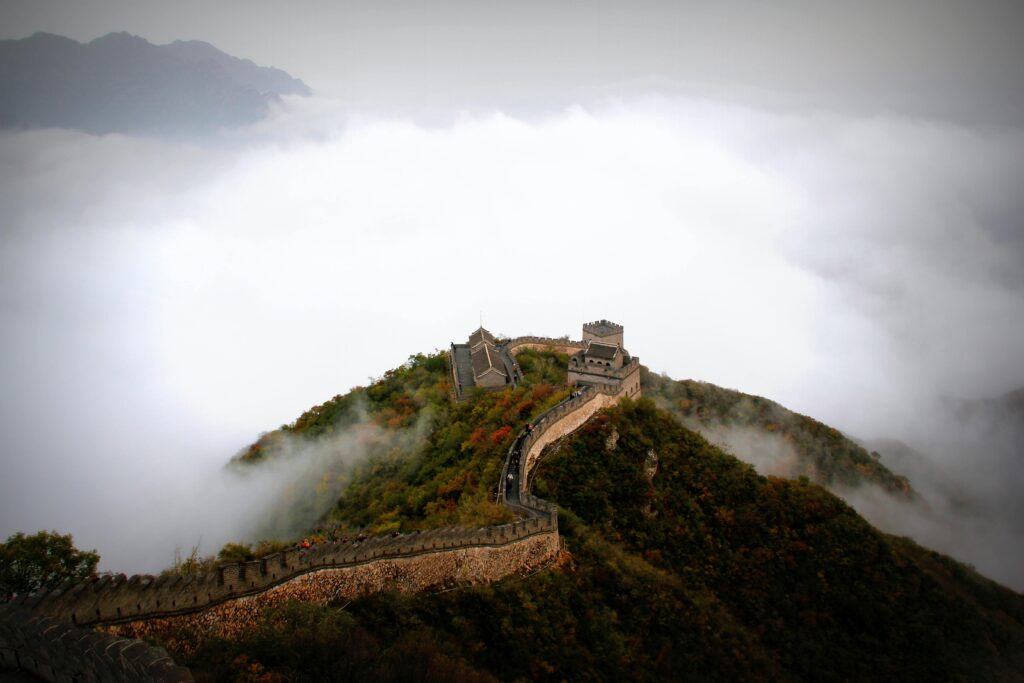The Great Wall of China: A Tale of Stone and Time
Let me take you back—over 2,000 years ago—when ancient China was a land of warring states and unending turmoil. Picture vast, untamed landscapes, where danger loomed beyond the mountains and open plains. It was here, amidst fear and ambition, that the story of the Great Wall began.

The Birth of a Wall: A United Dream
The year was 221 BCE, and the first emperor of China, Qin Shi Huang, had just unified a fractured kingdom. But with unity came a new challenge—the nomadic tribes of the north, fierce warriors who raided with no warning. To keep his empire safe, the emperor envisioned a colossal barrier, stretching across the wilderness like a shield.
But this was no ordinary wall. Qin didn’t build it from scratch. He ordered the connection and reinforcement of existing walls, previously built by smaller kingdoms during the Warring States period. With his command, a wall of earth and stone began to rise, snaking through valleys and mountains, defying nature itself.
A Labor of Blood and Sweat
Building the Great Wall was no easy feat. Tens of thousands of workers—farmers, soldiers, and prisoners—were conscripted for the monumental task. They toiled under the blazing sun and biting winds, carrying heavy stones and tamping earth by hand.
The wall wasn’t just a physical barrier; it was a human sacrifice. Legends say the workers’ cries became whispers in the wind, and their bones were buried within the wall itself. Stories like “Meng Jiangnu’s Tears” tell of a woman who wept so deeply for her husband’s death during construction that a section of the wall crumbled.
A Wall Through Dynasties
Qin Shi Huang’s vision was only the beginning. Over the centuries, new emperors would add their own chapters to the story of the Great Wall. The Han Dynasty extended it westward to protect the Silk Road, ensuring safe passage for merchants trading silk, spices, and other treasures.
But it was during the Ming Dynasty (1368–1644) that the wall as we know it took shape. The Ming emperors, threatened by powerful Mongol forces, rebuilt and fortified the wall with bricks and stones, creating massive watchtowers, battlements, and strongholds. It became more than a defense—it was a symbol of the empire’s might and ingenuity.
The Guardians of the Wall
Imagine standing on a misty mountain ridge, a lone sentry peering into the distance from one of the Great Wall’s watchtowers. Signal fires were lit to warn of approaching enemies, creating a chain of communication that spanned hundreds of miles. The wall wasn’t just a barrier; it was alive with soldiers, ready to defend the empire at a moment’s notice.
Beyond Defense: A Cultural Monument
As time passed and China’s borders expanded, the wall’s purpose shifted. It was no longer just a line of defense but a cultural monument, a reminder of China’s resilience and unity. Travelers and poets stood in awe of its immensity, describing it as a dragon weaving through the mountains.
A Modern Marvel
Today, the Great Wall of China is one of the world’s greatest wonders. Stretching over 13,000 miles, it passes through deserts, forests, and mountains, an enduring testament to human determination. Though parts of it have crumbled with time, many sections have been lovingly restored.
Walking along the Great Wall today, you can almost hear the echoes of its history—the whispers of emperors, the songs of workers, the cries of soldiers. It’s a journey not just across stones but through the heart of a civilization.
The Wall That Stands Forever
The Great Wall is more than just a structure; it’s a story etched into the land, a reminder of humanity’s capacity to dream, build, and endure. Standing atop its ancient stones, you feel connected to the past, marveling at what was achieved against all odds.
As the sun sets behind the hills, the wall fades into the horizon, leaving you with a simple truth: the Great Wall of China is not just a piece of history—it’s a living legend.
1 thought on “The Great Wall of China”